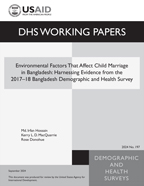There is no printed copy available to order.
Abstract:
Millions of teenage girls are affected by the
global issue of child marriage, which is a
violation of human rights. Compared to their
unmarried peers, girls who marry young face
disadvantages such as social exclusion,
poverty, and inadequate education.
In Bangladesh, the effects of climate change
are prevalent. The low-lying coastal towns
near the Bay of Bengal are vulnerable to
rising sea levels. The result of this is
flooding, river erosion, evidence of
waterlogging, and rising soil and water
salinity in some areas of Bangladesh.
Poverty and economic instability are commonly
understood to be the main drivers of child
marriage. However, despite growing interest in
the link between climate vulnerability and
child marriage, little research is available
on this topic. This paper examines how recent
environmental changes may have affected the
prevalence of child marriage in Bangladesh.
The study found that, among women age 20–49,
the prevalence of child marriage was lower in
Sylhet Division than in the other seven
divisions in Bangladesh. Clusters from the
coastal areas of Khulna, Barishal, and
Chattogram and clusters from the northeast
regions and from Sylhet had higher scores on
the climate vulnerability index (CVI) than
other clusters. We also found a correlation
between the CVI developed in this study and
the prevalence of child marriage, although the
magnitude of this association varied by
division. CVI was most strongly correlated
with child marriage in Barishal and Rangpur,
which are disaster prone in the context of
coastal and drought conditions. Nationally,
the correlation coefficient for the
relationship between CVI and child marriage
was almost 18% and highly significant (p <
.001).
 Environmental Factors That Affect Child Marriage in Bangladesh: Harnessing Evidence from the 2017-18 Bangladesh Demographic and Health Survey (PDF, 1438K)
Environmental Factors That Affect Child Marriage in Bangladesh: Harnessing Evidence from the 2017-18 Bangladesh Demographic and Health Survey (PDF, 1438K)
